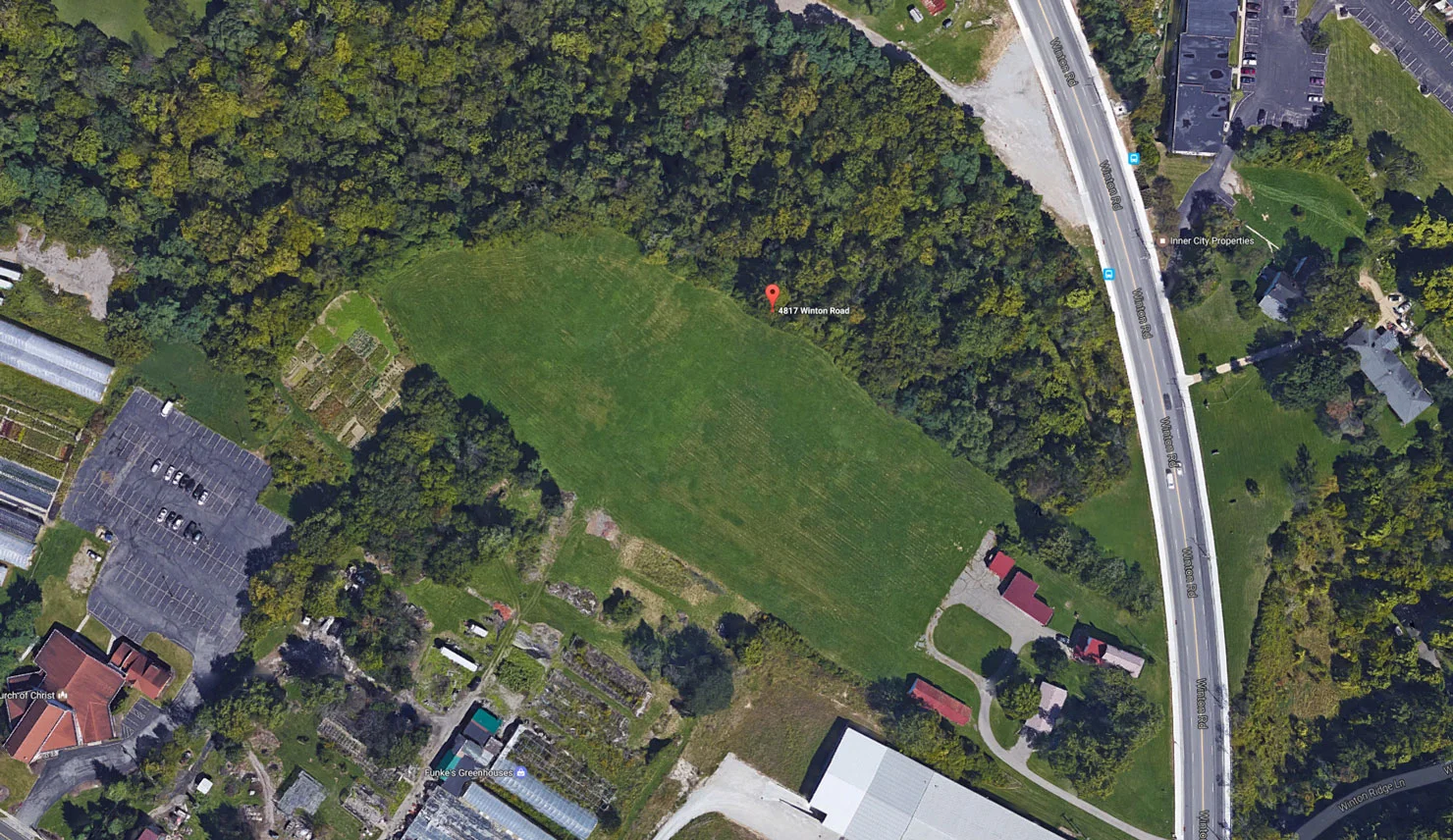Authors: David N. Rosenberg (farmer and owner of Wooden Shoe Gardens), with Alan Wight, and edited by Deborah Jordan
Introduction
On December 15th, 2016, Larry Falkin from the City of Cincinnati’s Office of Environment and Sustainability (OES) hosted a meeting to talk about a special piece of land: The Kettler Property located at 4817 Winton Road. Thirty people attended with the interest of saving the land for agriculture purposes. This parcel had recently been put on the market and as of this publication date, is still for sale. The property is about 14 acres and includes 9 acres of prime, fertile soils that had previously used for agriculture. There are 2 houses and several outbuildings on the property. The asking price: $800,000.
The Kettler Property sits to the east of Gray Road, just north of Spring Grove Village, and southwest of Wooden Shoe Hollow. This area of Cincinnati is one of the remaining agricultural districts—it includes Osterbrooks, Funky’s and AJ Rahn’s Nurseries, my farm (Wooden Shoe Gardens), and Homeadow Song Farm, which is owned and operated by Vicki Mansoor, Peter Huttinger, and Karen Egan. Plus, if you travel northwest up Winton Road, you come to the Bahr Farm, a main growing site for Our Harvest Cooperative.
There were some novel ideas presented at the meeting: a farm incubator to help new farmer’s learn the skills, share tools, and trade ideas; an ecovillage style agri-community that would support the elderly; an educational farm; and/or maybe some light development near that road that would preserve the main fields for production. One suggestion from Robin Henderson of OES was that we think of this entire area as “An Agro-Tourism Corridor.” What is clear, is that this meeting and the conversation caused me think a little deeper about urban farmland and our next generation of farms.
The Kettler Property located at 4817 Winton Road
How Will We Develop Our Next Generation of Urban Farms
I started my farm in 1976 and have been cultivating 11 acres since then. I remember going to the Terminal Market in 1978, which was located down by the riverfront, before the new stadium was built. This was our “food hub,” a place where farmers could bring their produce and find a buyer. The commission house took 15% of the final sale, but the rest went into the farmer’s pocket. As the years progressed, I recall that every farming family in Wooden Show Hollow was discouraging their children from careers in agriculture. The writing was on the wall—smaller scale agriculture was on its way out. Everyone assumed the Hollow would be developed. Oh how things have changed. Where is our Terminal Market today and where are our urban farms?
From a farmer’s point view, I think many of our land access problems would be solved if small to medium size farms (1 – 50 acres) could actually earn a living. Think about it: middle class families spend 6 figures to get a home mortgage in our county. For a farmer to own and work a piece of land, they should be able to make enough money needed to pay their mortgage. What I mean here is that farmers should be in the middle class. We should be able to afford a house, pay our bills, send our kids to college, and retire with dignity. Yet, the reality is that farms do not earn enough money to pay back their mortgages. I believe we need new economic models that properly value our land and the food we produce.
Rural land doesn’t seem that expensive to me. If I could move my farm to CornandBean County, Ohio, I could purchase land worth a fraction of the cost of my city farm. Whether I could sell the produce successfully is another conversation. On the other hand, land in and around cities is priced too high for agricultural purposes. To any farmer, renting my packing shed for $500 per month seems feudalistic, but there’s a long line of other types of small businesses that would love to have the space at that price. The bigger problem is that farmers don’t have the opportunities to earn this kind of money right now.
So what’s a retiring farmer to do given these financial circumstances? I contend that if new urban farmers had higher chances for success, the dilemma would be resolved. To be clear, to me success means having a viable business, selling my produce for a fair price, being able to pay my bills on time, educate my children, pass the land onto the next generation, and of course retire without having to worry about selling land to make ends meet. I have felt my entire life that if the business employs the entire family, it should support the entire family. This is currently not the case, as most farmers (and/or their spouses) who are able to survive (not thrive) right now, have off-the-farm income. There is something really wrong with this picture.
There is a long list of reasons why we should have more urban agriculture. Yet, I’m not happy with the current thinking about how to procure and save land for future generations at the expense of retiring farmers. To some extent I blame public policy, a general disrespect for the land and oligopolistic power that squeezes out the less fortunate. I do understand why city land prices are more expensive—urban and suburban sprawl from development pressures. As a result, I feel like the entire food industry has suffered over the last 70 years, since WWII, and it could take decades to reverse this near century of poor decision making.
Why have city planners not helped save farmland? Agricultural land in and around cities is so valuable. Think about it, farmers (can) provide key services to the city: from food, to protecting green space and watersheds, and helping with compost and the recycling of organic matter. Instead, our city is spending millions to truck organic waste to Rumpke. Then there are also the related sewer and storm water issues. We are spending 3 billion in Hamilton County alone to address our combined sewer overflow!
So how do we change the agricultural landscape from survival to prosperity?
I think the next generation of farmers, with input from older farmers, has a huge role to play in advancing food security while increasing the livability of our city. We need better working models and business plans for urban farms so they can actually make a living, pay their mortgage, and have financially viable career. We need to reassess how we measure success. Currently we measure success as survival, but it should be prosperity.
Progressive urban and agricultural economists have measured the economic value of having productive farmland in cities (Geoghegan, 2002; Livanis et al., 2006; Nickerson & Lynch, 2001; Vallianatos et. al., 2004) Some of their conclusions suggest that city governments should buy up the land at market price and preserve it for future economic, environmental, and health reasons – all of which would increase the livability and quality of life within our municipalities. I could not agree more, I think our city government; specifically our office of economic development should buy and help preserve farmland, ensuring that it is used to produce food. This is the level of discussion we need to have to encourage a sustainable local food movement. While this task of renewal is daunting, it is nonetheless necessary, and is what we need to collectively focus our efforts on today.
While there is much to be done, it is important to acknowledge the good work and progress that is slowly being made around protecting urban farmlands. The Southwest chapter of the Ohio Ecological Food and Farming Association (SWOEFFA) has been giving farmers a voice for decades. The Office of Environment and Sustainability and the City Health Department have been working on these issues since at least 2009, when they formed the Urban Farming Program. The Greater Cincinnati Regional Food Policy Council has developed guidelines for preserving agricultural lands (both rural and urban). On July 1st, 2017 our City Council passed a Motion on Urban Agriculture, which calls for more integration and collaboration between city departments to identify and save land for growing; increase land availability to farmers; provide them with water access, extended leases, and first rights of refusal regarding possible acquisition. Plus, this motion asks for the creation of urban agriculture pilot projects.
This is a great start, but I still believe we need farmers, food justice advocates, and concerned citizens to tell the public and our elected officials to make land access and preservation a higher priority. Small and large businesses alike need to commit to buying food from our farmers. City governments and their economic departments have a crucial role to play. The current interest in local food has never been greater in my lifetime. That means we have lots of potential partners to help us succeed.
References and Links:
Grigorios Livanis, Charles B. Moss, Vincent E. Breneman, and Richard F. Nehring. "Urban Sprawl and Farmland Prices." American Journal of Agricultural Economics 88, no. 4 (2006): 915-29. http://www.jstor.org/stable/4123536.
Geoghegan, Jacqueline. "The value of open spaces in residential land use." Land use policy 19, no. 1 (2002): 91-98.
Nickerson, Cynthia J., and Lori Lynch. "The effect of farmland preservation programs on farmland prices." American Journal of Agricultural Economics 83, no. 2 (2001): 341-351.
Vallianatos, Mark, Robert Gottlieb, and Margaret Ann Haase. "Farm-to-school: Strategies for urban health, combating sprawl, and establishing a community food systems approach." Journal of Planning Education and Research 23, no. 4 (2004): 414-423.
Greater Regional Cincinnati Food Policy Council - Agriculture and Land Use Policy Recommendation:
Urban Farming Program:


